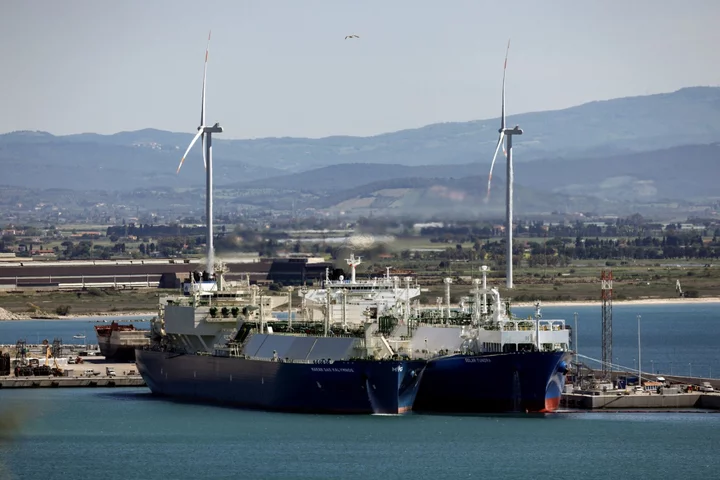Europe rushed to secure liquefied natural gas in an effort to ease a crippling energy crisis. Now, there’s a chance its plans to build more import terminals for the fuel have gone too far.
From France to Poland, the region is looking to build LNG infrastructure after Russia severely curtailed pipeline supplies in the wake of its invasion of Ukraine. But this capacity could significantly outpace demand for the fuel post 2030 as countries increasingly embrace renewable energy.
If all planned terminals are built, there’s a risk that billions of euros in infrastructure could become stranded assets in the long run.
“Some of the investments in LNG import infrastructure were made by markets based on the assumption that there’s always going to be demand somewhere in Europe,” said Ogan Kose, a managing director at Accenture Plc who specializes in gas. “However, if every country aims to have its own import capacity, and markets are not going to operate in collaboration, then of course there will be a lot of sunken costs.”
For now, new LNG terminals are popping up in multiple countries, with the energy crisis still in focus. Italy is nearing the start of its fourth facility. Germany is pushing to deploy its fourth floating terminal, off the Baltic island of Ruegen. Such structures are often preferred as they are cheaper and quicker to build than those on land. Other projects are planned in countries including Estonia and Greece.
Read More: Estonia and Latvia Agree on Crisis Plan for LNG to Ensure Supply
Yet, estimates for LNG demand vary. S&P Global Commodity Insights expects purchases of the liquefied fuel to peak in 2028-29 before easing in the following decade, albeit to levels that could still be higher than in 2022. Some other industry watchers estimate a deeper drop in consumption in the 2030s.
Meanwhile, Europe’s LNG import capacity may jump about 50% by the end of this decade, according to the Institute for Energy Economics and Financial Analysis. And half of that could be left unused at some point, the researcher said in a March report.
Short-Term Demand
The continent survived the crisis last winter without any major supply disruptions due to unseasonably mild weather, lower energy consumption and an influx of LNG. As a result, gas storage levels are now well above normal for the time of year.
Still, ships are hauling record levels of LNG to the continent as risks for next winter loom. On peak days, existing facilities have operated at full capacity, leaving LNG tankers idling at sea waiting to discharge their cargoes.
For the moment, Europe has little choice but to construct new infrastructure to handle current demand for LNG. Terminals aren’t built to run at full capacity all year, and it’s common for them to have an annual average utilization rate of 50%-70%, or even less.
The region could add another two to four floating terminals beyond those already being planned, said Thomas Thorkildsen, chief commercial officer at Hoegh LNG, which provided Germany with two such units for 10 years.
“We see strong interest for more capacity in several northwestern European countries,” he said in an interview. “However, there are opposing viewpoints, and political processes and decisions need to be concluded before commitments are made.”
Long-Run Risk
The concern is a lack of demand in the long-run. The European Union may slash its gas usage by almost 45% by 2030 as it moves toward renewable energy sources, under one scenario forecast by the International Energy Agency.
To be sure, capacity at some of Europe’s existing terminals is booked as far out as 2045 or even 2050, according to Elengy SA, which operates three land-based terminals in France and had an average utilization rate at a record 95% last year.
The EU sees extra capacity as a buffer to provide energy security. In addition, floating storage units can operate as LNG carriers if demand for capacity fades. They can also be moved to other locations, such as growing markets in Asia. Some new terminals could be converted to use other products like ammonia or hydrogen.
Read: How Germany’s LNG Terminals Will Morph Into Green Hydrogen Hubs
Europe will still need LNG in 2030 and even beyond, said Esther Ang, head of LNG at Swiss trader MET International AG. More export projects — from the US to Qatar — will add supply to fill the markets.
“There are more LNG projects in the world now than in the past,” she said in a recent interview in Amsterdam. “There will be times when these assets will be definitely needed, and times with potentially lower demand — but it’s all about managing this risk.”
(Updates with data from S&P Global Commodity Insights in the sixth paragraph, chart.)

